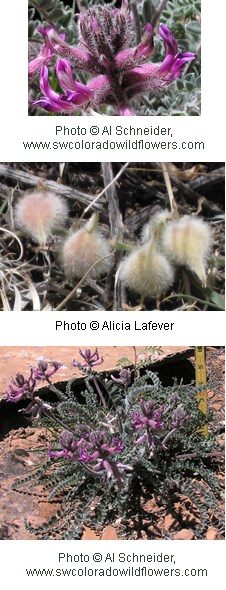
Astragalus mollissimus var. thompsoniae Family: Fabaceae (A Utah Flora – Leguminosae) – Pea Family Perennial herbs; 2.4” to 1.5' (6 to 45 cm) tall Leaves: alternate; compound; dense hairs on both sides; 15 to 35 leaflets; leaflet 0.08” to 0.72” (2 to 18 mm) long, 0.04” to 0.56” (1 to 14 mm) wide; leaves 0.8” to 11.2” ( 2 to 28 cm) long Flowers: 5 pink or purple petals (a banner, 2 wings and 2 keels); the keel is shorter than the wings; 5 toothed sepals; 5-10 stamens, 1 pistil; bisexual; racemes with 7 to 20 flowers; flowers 0.72” to 1” (18 to 25 mm) long Pollinators: other Astragalus species are pollinated by bees, moths and butterflies Fruits: densely hairy legume Blooms in Arches National Park: February, March, April, May, November Habitat in Arches National Park: grassland, desert shrub and pinyon-juniper communities Location seen: park road mile 5 to 7, 7.3, Broken Arch, near Devils Garden campground amphitheater, park road Petrified Dunes to Devils Garden Other: The genus name, “Astragalus”, is the Greek name for “legume”, and may be derived from “astragalos” which means “ankle bone” referring to the shape of the leaves or the pods. The species name, “mollissimus”, means “most soft” referring to the dense hairy covering of the leaves and stems, which inspired the common name. The woolly locoweed is one of the first Astragalus species to flower in Utah. This plant contains an alkaloid, locoine, which can cause livestock to "go loco" or even die if they eat too much of this species. This family is ranked second to grasses in importance to people because species can fix nitrogen. However, some species, e.g., locoweeds and milkvetches, are poisonous due to selenium abstracted from the soil. |
Last updated: April 29, 2025
